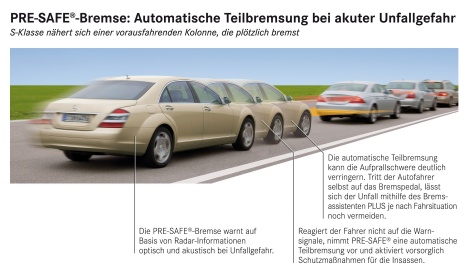Mercedes-Benz to focus on climate protection as much as they focus on safety
Muamer Hodzic November 11, 2008
Mercedes-Benz will continue its comprehensive commitment to road safety and, at the same time, take further major strides forward in its quest to reduce both fuel consumption and emissions. These were just some of the key statements made by the Mercedes experts at a conference in Leipzig, signalling the start of a new safety initiative for 2009. The car is becoming part of the thinking process, with the capability to assist the driver in keeping with the current situation or act autonomously whenever there is a risk of an accident.
“We will not let up in our long-standing quest to make motoring even safer and further reduce the number of road accidents”, said Dr Thomas Weber, Daimler AG Board of Management member responsible for Group Research and Development Mercedes-Benz Cars. He added that there would also be no let-up in the drive to reduce fuel consumption and CO2 emissions. Dr Weber: “We afford and will continue to afford equal importance to safety and climate protection.”
He also stated that the new E-Class, due to celebrate its world premiere in spring 2009, would show that further important advances were possible in both domains. This Saloon sees Mercedes-Benz extending its safety concept based on real-life accidents by introducing new assistance systems such as ATTENTION ASSIST (for detecting drowsiness), Adaptive Highbeam Assist and the PRE-SAFE®brake (an automatic emergency braking system). “The new E-Class will be the safest car in this market segment and, at the same time, consume far less fuel than its predecessor thanks to new engines, intelligent energy management and a raft of other measures”, explained Dr Weber.
Following on from the successes achieved in the domain of occupant protection, Mercedes-Benz will be focussing more than ever on avoiding traffic accidents and reducing accident severity, with the dozen or so new or modified driver assistance systems making their debuts in the new E-Class and the model year 2009 S-Class set to play a crucial role. “Thanks to the globally unique interaction of state-of-the-art safety technology, we are able to extend the cars’ ‘senses’ and enhance their intelligence. Mercedes models therefore become part of the ‘thinking’ process and are capable of seeing, feeling, reacting instinctively and acting autonomously,” said Ulrich Mellinghoff, Head of Mercedes Safety Development, speaking in Leipzig.
Like tried-and-trusted Mercedes inventions such as ABS, ESP®, Brake Assist and PRE-SAFE®, the new assistance systems have been adapted based on real-life traffic and accident findings. The aim behind their development was to prevent frequent types of collision and collisions with serious consequences by focussing on the causes of accidents such as distance to other vehicles, speed, drowsiness, darkness and lane departure.
Safety development founded on accident research and experience
When it comes to the further development of occupant protection systems, Mercedes-Benz will likewise continue to concentrate on real-life accidents. Mellinghoff: “For us, car safety means more than just passing statutory crash tests or crash tests specified by rating organisations. Whilst these laboratory tests are right and important for evaluating cars’ impact resistance, they are merely a snap-shot of what actually happens in an accident.”
According to the Sindelfingen-based experts, the knowledge of how to build safe cars can be gleaned on the road – quite literally. They point to the long-standing tradition of Mercedes safety development, which has yielded practically every innovative safety technology now used in passenger cars, from the crumple zone to ESP®. All of these inventions were preceded by painstaking accident analyses which highlighted how to avoid collisions and enhance occupant protection. Some 3800 serious road accidents have been scrutinised since Mercedes set up its own in-house accident research facility – vital preparatory work for ensuring the on-going development of passenger-car safety.
Around 40 different crash tests. One shining star
Rating tests are just one aspect of Mercedes-Benz’ extensive programme of crash testing. Whereas only two crash tests (frontal and side impact) are required for a brand-new car to gain approval in the EU/ECE, and the coveted five-star Euro-NCAP rating can be achieved by taking part in just three impact tests, Mercedes models have to pass 25 further approval and rating crash tests. These are required in order to be able to sell the cars all over the world.
Then there are nine extremely demanding in-house tests, devised based on real-life accidents. Ulrich Mellinghoff: “A new model such as the E-Class nowadays has to come through a total of around 40 different crash tests before it can be passed as fit for series production. Only cars which pass this tough examination get a star: the Mercedes star.”




